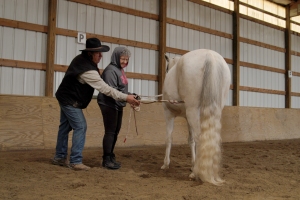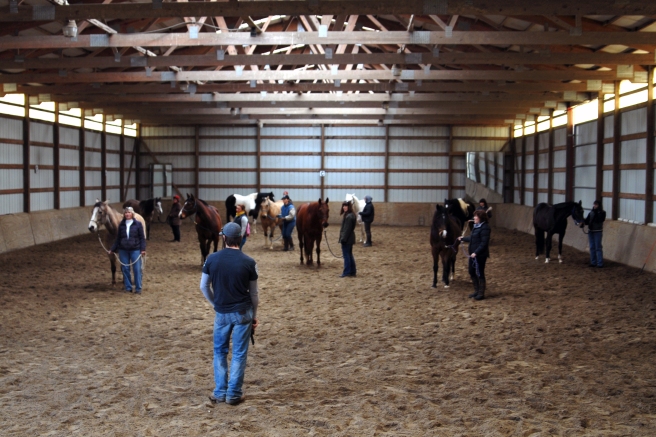
The more I learn about Centered Riding the more I like it. The clinic today had a recurring theme of analogous parts – our own body parts all have synonymous parts on our horse, and those parts link up. Hold tension in your back, your horse holds tension in her back. Hold your breath, your horse holds her breath. I’ve learned this lesson before, but seeing this illustration really made it click for me:

A year and a half ago, I wrote about how Adriene identified the tension in my chin, neck and jaw. That was causing tension in Robbye’s neck and jaw. Well apparently I’ve released the tension in my jaw (I HAVE been working on it for…a while), but I’ve intensified the tension in my neck. When I hold tension in my neck, it shortens up. When Robbye holds tension in her neck, it shortens up. Completely the opposite of what I’ve been working so hard to fix the past few months.
So I’ll be practicing lengthening my neck and releasing the tension from it so that Robbye can work on doing the same thing.
That was my main takeaway from the lesson, but of course there were others!
- I need to put float my hands (like there are balloons attached) a little more and put more weight back into my elbows. This is something I think I’ve improved a lot on in the past year, but still needs more.
- I reverted back to pulling on Robbye when she’s being distracted or silly. I thought this was a habit I had finally broken, so I’m disappointed in myself. I always feel more comfortable with her silliness the more forward we go, and I need to remember to let that forward out!
- I need to steer more with my seat and less with my hands. Another habit I’ve been working on but needs more training on my part.
The lesson was supposed to be a jumping one, but we spent so much time dealing with tension that I ran out of time. However, I did get to express to her my frustration with my jumping seat: although I know that my position is horrible, and I know academically what 2-point is and how to achieve a nice one, I have struggled and struggled to actually translate to my own body. It’s gotten to the point where I dislike jumping because I feel so ugly and ineffective in the air.

So with the time remaining Adriene coached me into a nice 2-point (on the flat). First, she lowered my stirrups (interesting – this is the second time in a row she’s lowered them…and she was the one who put them all the way up in the first place. I wonder if my body is changing from all the dressage? Is that even possible?). That made a huge difference in where my thigh and lower leg hung. Plus, I no longer feel like I’m launching myself out of my saddle when I post!
Next, she changed where I place my stirrups on my feet. She showed me that there’s a specific place on the foot where the “springs work best”; the ankle knee, and thigh flex easily and naturally, but the position isn’t compromised.

Finally, she showed me what the position is supposed to be like. I don’t know why it’s so hard for me to achieve it – goodness knows I’ve read enough articles and watched enough videos, but I think I finally understand what it’s supposed to feel like. I let my weight sink into my lower leg without letting it wander forward or backward, pulled my thigh off the saddle (no gripping!), imagined I had an airplane seat-belt on to pull my hips back, and let my upper body naturally go where it would.
I think that may have been my misunderstanding – I was trying to fix my upper body without knowing what my legs and hips were supposed to do.
(Analogous parts! A nice front will follow a correct hind! Full circle!)
After trying to commit the feeling to memory, I walked and trotted around in my new 2-point. I started to feel the muscle ache, which I was very happy about – my standing-in-the-stirrups version of 2-point took zero effort (and was ugly and I’m sure Robbye hated me for it). I also felt my legs turn into springs – something Adriene said will help my sitting trot as well. YAY.
Even though the lesson was a whole lot of talking, standing, and walking, I came away with more tools to deal with tension and with an epiphany about what 2-point feels like. I’m really really really excited to get back to jumping now – finally.

















































































